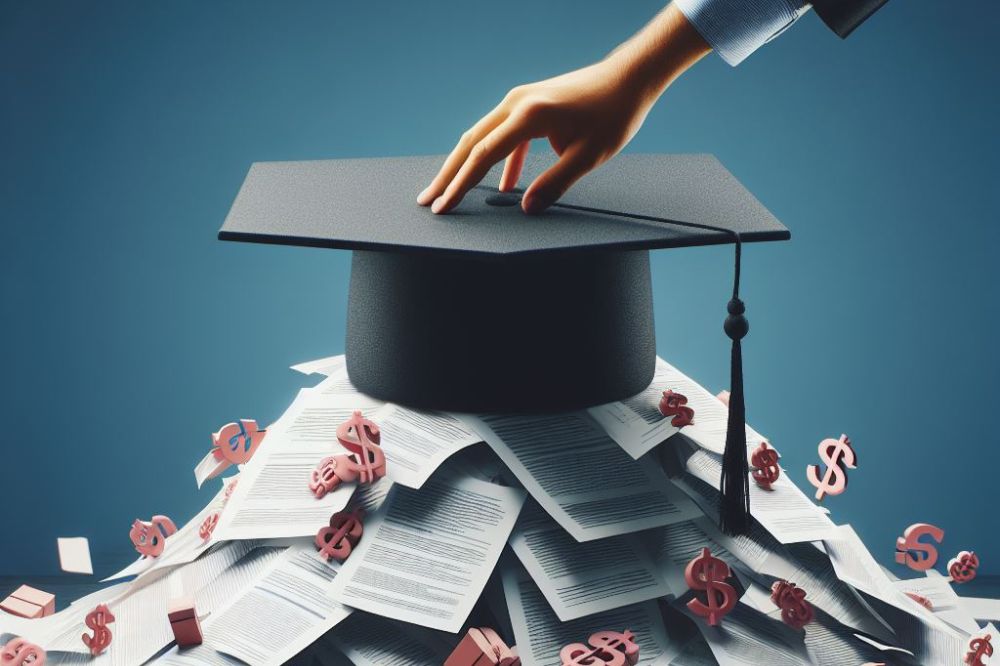When it comes to navigating the complex landscape of bankruptcy, understanding the critical role of student loan servicers is paramount. These entities play a pivotal role in managing repayment plans and assisting borrowers through financial challenges. However, the contrast arises when exploring how student loan servicers operate within the context of bankruptcy proceedings. While they are tasked with facilitating solutions for borrowers, their approach can sometimes conflict with the goals and needs of individuals seeking relief through bankruptcy. Understanding this dynamic is essential for anyone grappling with student loan debt and considering bankruptcy as a potential solution.
Key Takeaways
- Understanding the complexities of bankruptcy and how it affects student loans is crucial for borrowers facing financial challenges.
- Student loan servicers play a significant role in the bankruptcy process, impacting how borrowers navigate their debt repayment options.
- Borrower stories illustrate the real-life implications of dealing with student loans in bankruptcy, highlighting the importance of seeking guidance and support.
- Legal protections exist for borrowers to safeguard their rights and ensure fair treatment when addressing student loan debt in bankruptcy.
- Identifying discharged debt accurately is essential for borrowers to avoid unnecessary financial burdens and understand their post-bankruptcy obligations.
- Practical advice, such as seeking professional assistance and staying informed about changing regulations, can empower borrowers to make informed decisions regarding their student loans and bankruptcy.
Understanding Bankruptcy
Basics Explained
Student loan servicers play a crucial role in bankruptcy by managing borrowers’ accounts. They are responsible for collecting payments, processing paperwork, and providing customer service. Understanding their role is essential for navigating the bankruptcy process effectively.
Student loan servicers have key responsibilities such as communicating with borrowers about repayment options and assisting with deferment or forbearance requests. Their actions can significantly impact borrowers’ financial situations. It is vital to be aware of how they operate within the bankruptcy framework.
Highlighting the importance of understanding student loan servicers’ functions can help borrowers make informed decisions regarding their loans during bankruptcy. Being knowledgeable about how servicers operate can empower individuals to advocate for themselves and seek appropriate solutions.
Myths Debunked
Private Loans
Private loans in bankruptcy present unique challenges compared to federal loans. Unlike federal loans, private loans may not offer the same protections or forgiveness options during bankruptcy proceedings. Borrowers with private loans often face stricter repayment terms and fewer opportunities for relief.
The implications of private loans in bankruptcy include limited options for restructuring or reducing payments. Borrowers may encounter difficulties negotiating with private lenders compared to federal loan servicers. Navigating the complexities of private loan bankruptcy requires careful consideration and strategic planning.

Discharge Misconceptions
Common misconceptions about student loan discharge in bankruptcy include the belief that all student debt is automatically eliminated. In reality, discharging student loans in bankruptcy is a challenging process that requires meeting specific criteria. Misunderstandings about discharge eligibility can lead to unrealistic expectations and frustrations for borrowers.
Clarifying the criteria for discharging student loans involves demonstrating undue hardship or proving that repayment would cause significant financial strain. Navigating the nuances of student loan discharge demands thorough documentation and legal expertise. Understanding these complexities is crucial for pursuing successful discharge outcomes.
Bankruptcy Types
Chapter 7
Chapter 7 bankruptcy impacts student loans differently than Chapter 13. Under Chapter 7, discharging student loans requires proving undue hardship through an adversary proceeding. The eligibility criteria for Chapter 7 include passing a means test based on income and expenses.
Discharging student loans under Chapter 7 involves demonstrating that repaying them would cause undue hardship, which is a stringent standard to meet. Navigating the requirements for Chapter 7 bankruptcy necessitates legal guidance and comprehensive evidence of financial distress.
Chapter 13
Chapter 13 bankruptcy offers repayment plans that allow borrowers to restructure their debts over time, including student loans. Unlike Chapter 7, Chapter 13 does not require proving undue hardship for discharging student loans but focuses on creating manageable payment arrangements.
Comparing Chapter 13 with Chapter 7 reveals distinct approaches to addressing student loan debt within the bankruptcy framework. Choosing between these chapters depends on individual financial circumstances and goals regarding debt resolution.
Student Loans in Bankruptcy
Discharge Criteria
Student loans can be discharged in bankruptcy if specific criteria are met, primarily proving undue hardship. This involves demonstrating that repaying the loan would prevent a minimal standard of living. Legal requirements for undue hardship vary across jurisdictions and often require a three-pronged test to be satisfied. Examples of successful discharge include severe disability or long-term unemployment.
Federal vs Private
Treatment Differences
Federal and private student loans are treated differently in bankruptcy proceedings. Federal loans offer more flexible repayment options compared to private loans, which may have higher interest rates. Under Chapter 7, federal loans may be discharged after proving undue hardship, while Chapter 13 involves creating a repayment plan. These differences impact borrowers’ ability to manage their debt effectively.
Repayment Plans
Various repayment plans exist for student loans in bankruptcy, such as income-driven plans or extended repayment options. Pros of income-driven plans include payments based on income level, while cons may involve longer repayment periods leading to higher overall interest payments. Choosing the most suitable plan depends on factors like income stability and future financial prospects.
Filing Process
Adversary Proceedings
Adversary proceedings are legal actions within bankruptcy cases that specifically address issues related to student loans. They are initiated when there is a dispute over the dischargeability of student loan debt or when fraud is suspected. Outcomes of adversary proceedings can vary from full discharge to modified repayment terms based on individual circumstances.
Documentation Needed
Essential documentation for student loan bankruptcy includes proof of income, tax returns, loan statements, and evidence of financial hardship. Accurate and complete documentation is crucial for supporting claims of undue hardship or eligibility for specific repayment plans. Organizing documents systematically and submitting them promptly can streamline the bankruptcy process.
Role of Servicers
Account Management
Student loan servicers play a crucial role in managing borrower accounts during bankruptcy. They handle tasks such as processing payments, updating account information, and providing guidance. These servicers may have different approaches to account management, leading to variations in how borrowers are assisted.
Common issues related to account management in bankruptcy include confusion over payment plans, inaccurate reporting of account statuses, and delays in processing paperwork. Borrowers may face challenges navigating these complexities during a financially stressful time.

Communication Channels
Notices and Statements
Notices and statements from student loan servicers are vital during bankruptcy proceedings. These communications inform borrowers about account status, payment due dates, and any changes in terms. Understanding the information included in these notices is essential for borrowers to stay informed about their obligations.
Interpreting and responding to notices and statements requires attention to detail. Borrowers should carefully review the content, seek clarification if needed, and respond promptly to any requests or updates provided by the servicer.
Customer Service
When evaluating customer service provided by student loan servicers in bankruptcy cases, prompt responsiveness, clear communication, and knowledgeable support are key indicators of quality service. However, borrowers often encounter challenges such as long wait times, inconsistent information, and difficulty reaching a resolution.
To effectively communicate with customer service representatives, borrowers should keep detailed records of interactions, ask for names and reference numbers for documentation purposes, and escalate concerns if necessary to higher levels of authority.
Collection Practices
Before Discharge
Before attempting to discharge student loans in bankruptcy, borrowers should gather all relevant financial documents, including income statements, tax returns, and loan agreements. Building a strong case for discharge involves demonstrating financial hardship or other qualifying factors that justify relief from loan obligations.
Seeking professional advice from bankruptcy attorneys or financial advisors is crucial before pursuing discharge. These experts can provide guidance on legal options, potential outcomes, and steps to take throughout the process.
After Discharge
After student loans are discharged in bankruptcy, borrowers must understand their post-discharge obligations. Remaining compliant with any repayment plans, attending required counseling sessions (if applicable), and staying informed about any residual balances are important responsibilities for borrowers.
Challenges may arise after student loan discharge, such as creditors attempting to collect discharged debts or errors on credit reports. Borrowers should be vigilant about monitoring their credit history post-discharge to address any discrepancies promptly.
Borrower Stories
Discharge Violations
Student loan discharge violations in bankruptcy are unfortunately common. Borrowers often face challenges when trying to discharge their student loans through bankruptcy. Servicers may provide inaccurate information or fail to comply with legal requirements. These violations can have severe consequences for both borrowers and servicers.
One significant consequence of discharge violations is that borrowers may continue to be burdened by their student loans even after filing for bankruptcy. This can lead to financial hardship and prolonged stress for individuals seeking relief from their debts. In some cases, discharge violation issues can result in legal action against servicers for non-compliance with bankruptcy laws.
Examples of discharge violation cases highlight the impact on borrowers. For instance, a borrower may have their bankruptcy case dismissed due to incorrect information provided by the servicer, prolonging their financial struggles. In another scenario, a servicer’s failure to process a borrower’s discharge request promptly can lead to additional interest accrual, increasing the overall debt burden.
Collection Concerns
Industry Practices
The prevailing practices of student loan servicers in the bankruptcy industry play a crucial role in shaping borrowers’ experiences. Servicers are expected to adhere to specific guidelines and regulations when handling bankruptcies involving student loans. However, there have been instances where servicers have been criticized for engaging in aggressive collection tactics or providing misleading information to borrowers.
Analyzing industry practices reveals trends and developments that impact how servicers interact with borrowers during bankruptcy proceedings. Some servicers prioritize maximizing collections over assisting borrowers in navigating the complexities of bankruptcy, leading to increased frustration among those seeking relief from their debts.
Areas for improvement in industry practices include enhancing transparency in communication with borrowers, ensuring accurate information dissemination, and prioritizing borrower assistance over aggressive debt collection strategies. By focusing on consumer-centric practices, servicers can better support individuals facing financial difficulties during bankruptcy.
Consumer Complaints
Consumer complaints against student loan servicers in bankruptcy often revolve around issues such as improper billing, lack of responsiveness, and misinformation regarding repayment options. Filing a complaint against a servicer involves following specific procedures outlined by regulatory authorities or consumer protection agencies.
When consumers encounter problems with their student loan servicers during bankruptcy, they can seek resolution by lodging formal complaints through designated channels. Resources such as ombudsman services or consumer advocacy organizations offer support and guidance to individuals navigating complaints processes effectively.
Legal Protections for Borrowers
Automatic Stay
Automatic stay refers to the immediate halt of creditor actions against a borrower upon filing for bankruptcy. It shields borrowers from harassment and collection attempts, providing a breathing space. However, some exceptions exist, such as when creditors seek court permission to proceed despite the stay. These exceptions can impact borrowers by allowing certain actions to continue during bankruptcy proceedings.
Discharge Orders
Violation Consequences
Violating bankruptcy laws concerning student loans can lead to severe repercussions. Servicers found guilty of violations may face penalties like fines or even legal sanctions. For instance, in cases where servicers fail to comply with discharge orders, they might be penalized for disregarding legal directives. Such consequences serve as deterrents against misconduct by loan servicers.
Legal Recourse
Borrowers encountering issues with student loan servicers in bankruptcy have legal avenues to pursue. They can seek recourse through litigation or mediation, aiming to address violations or misconduct effectively. Consulting legal professionals becomes crucial for understanding the complexities of legal processes and receiving guidance on navigating them successfully. By seeking legal help, borrowers can protect their rights and interests throughout the bankruptcy proceedings.
Identifying Discharged Debt
Official Notices
Student loan servicers play a crucial role in bankruptcy proceedings by sending official notices to borrowers. These notices inform borrowers about the status of their loans and any potential changes. Types of official notices include notifications of discharged debt, updated repayment plans, or changes in loan terms.
Receiving official notices is legally significant as they provide essential information regarding the borrower’s obligations and rights during bankruptcy. It is important for borrowers to carefully review these notices to ensure they are aware of any developments that may impact their financial situation. Responding promptly and appropriately to these notices can help borrowers navigate the complexities of bankruptcy effectively.
When responding to official notices, borrowers should ensure that they understand the contents thoroughly. Seeking legal advice or guidance from financial advisors can be beneficial in interpreting the implications of these notices accurately. By staying informed and proactive, borrowers can protect their rights and make informed decisions regarding their student loans.

Servicer Records
Verification Process
During bankruptcy, student loan servicers engage in a verification process to confirm loan details and borrower information. This process involves validating the accuracy of loan amounts, interest rates, repayment schedules, and other pertinent data. Servicers verify this information to ensure compliance with legal requirements and facilitate transparent communication with borrowers.
Servicers use various methods to verify loan information, such as cross-referencing data with federal databases, contacting educational institutions, or requesting documentation from borrowers. Accuracy and transparency are paramount in this process to prevent errors or discrepancies that could impact the borrower’s financial standing. By maintaining precise records and verifying information diligently, servicers uphold accountability and trustworthiness in managing student loans.
Updating Records
Updating borrower records with student loan servicers is essential during bankruptcy to reflect any changes accurately. Borrowers should regularly request updates on their loan status, payment history, and contact information from servicers to ensure that records remain current and accurate. Keeping records up-to-date enables borrowers to stay informed about their financial obligations and access relevant assistance or resources when needed.
Maintaining accurate records also facilitates efficient communication between borrowers and servicers, reducing the risk of misunderstandings or delays in resolving issues related to student loans. Borrowers can request updates through formal channels provided by servicers or online portals dedicated to managing loan accounts. Verifying updated information ensures that borrowers have access to the most recent details concerning their loans, enabling them to make well-informed decisions regarding their financial future.
Preventing and Addressing Violations
Awareness and Education
Raising awareness about student loan bankruptcy rights is crucial for borrowers facing financial challenges. Education plays a pivotal role in empowering individuals to navigate the complexities of bankruptcy successfully. By understanding their rights and options, borrowers can make informed decisions regarding their student loans.
Educational resources such as workshops, online guides, and counseling services are essential for increasing awareness and knowledge about student loan bankruptcy. These resources provide valuable information on debt discharge, repayment plans, and legal protections available to borrowers. Empowering individuals with this knowledge can help prevent violations by student loan servicers.
Legal Assistance
Finding Help
Borrowers seeking assistance during student loan bankruptcy can turn to nonprofit organizations and legal aid services for support. These entities specialize in providing guidance and representation to individuals navigating the complexities of bankruptcy proceedings. Seeking professional help ensures that borrowers receive accurate information and support throughout the process.
Nonprofit organizations offer free or low-cost services to individuals struggling with student loan debt. Legal aid services provide legal expertise to help borrowers understand their rights and options when dealing with student loan servicers. By accessing these resources, borrowers can effectively address violations and misconduct by servicers.
Filing Complaints
Filing complaints against student loan servicers is a crucial step in addressing misconduct or violations during bankruptcy proceedings. Borrowers can lodge complaints through designated agencies or channels established to handle consumer grievances related to student loans. Proper documentation of complaints is essential for ensuring that grievances are addressed promptly.
Agencies responsible for overseeing student loan servicers’ conduct include consumer protection bureaus, ombudsman offices, and regulatory bodies. By following the appropriate channels for filing complaints, borrowers can hold servicers accountable for any wrongdoing or violations. It is important to follow up on complaints to ensure that resolutions are reached in a timely manner.
Future of Student Loans and Bankruptcy
Legislative Changes
Recent legislative changes have significantly impacted student loan bankruptcy laws. These updates aim to address the challenges faced by borrowers seeking relief through bankruptcy. The changes also affect student loan servicers, altering their roles and responsibilities in the process.
Analyzing the implications of these legislative updates is crucial for understanding how they shape the landscape of student loans and bankruptcy. Borrowers now have more options when it comes to navigating their financial difficulties through bankruptcy proceedings. However, these changes also introduce complexities that both borrowers and servicers must navigate.
Key provisions of the new laws affecting student loan bankruptcy include stricter eligibility criteria for discharge. This means that borrowers must meet specific requirements to qualify for debt forgiveness through bankruptcy. There are new repayment options available, providing borrowers with alternative paths to manage their student loan debt.

Advocacy Efforts
Within the realm of student loans and bankruptcy, advocacy efforts play a vital role in shaping policies and regulations. Advocates work tirelessly to ensure that borrowers’ rights are protected and that servicers fulfill their obligations ethically. These efforts often involve lobbying lawmakers and raising awareness about the challenges faced by those burdened with student loan debt.
Policy Proposals
In an effort to improve the student loan bankruptcy process, various policy proposals have been put forward. These proposals seek to streamline the discharge process for eligible borrowers, making it more accessible and efficient. The rationale behind these proposed policy changes lies in promoting financial stability for individuals struggling with overwhelming student loan debt.
Addressing potential challenges associated with implementing these policy proposals is essential. While streamlining the discharge process may benefit borrowers, it could pose logistical challenges for servicers tasked with managing a high volume of bankruptcy cases. Balancing efficiency with accuracy is key to ensuring fair outcomes for all parties involved.
Reform Movements
Reform movements advocating for changes in student loan bankruptcy regulations continue to gain momentum. These movements focus on addressing systemic issues within the current framework, aiming to create a more equitable system for borrowers seeking relief through bankruptcy. By highlighting the goals and strategies of these reform movements, individuals can better understand how they can contribute to positive change in this arena.
Providing ways for individuals to support and engage with reform efforts is crucial for driving meaningful progress in reshaping student loan bankruptcy regulations. Whether through grassroots activism or online campaigns, individuals can amplify their voices and push for reforms that prioritize borrower protections and fair treatment within the bankruptcy process.
Practical Advice for Borrowers
Pre-Bankruptcy Planning
When considering bankruptcy, effective pre-bankruptcy planning is crucial. Start by organizing your finances and documents systematically. This preparation ensures a smoother bankruptcy process and helps in presenting a clear financial picture.
Plan ahead by gathering financial statements, loan documents, and any other relevant paperwork. This organization simplifies the bankruptcy filing process, reducing stress and potential errors. Proactive planning can significantly impact the success of your bankruptcy case.
Post-Discharge Actions
Credit Repair
Student loan bankruptcy can have lasting effects on credit scores. Understand how this impacts your financial health and explore credit repair strategies. Rebuilding credit post-bankruptcy requires patience and discipline but is achievable with the right approach.
Explore resources that offer guidance on credit repair services and information. These resources can help you navigate the complexities of rebuilding credit after bankruptcy effectively.
Financial Management
After bankruptcy discharge, focus on financial management to secure long-term stability. Develop a budget that aligns with your financial goals and priorities. Utilize financial planning tools to track expenses, income, and savings effectively.
Maintaining ongoing financial management is essential for post-bankruptcy success. By implementing sound budgeting strategies and utilizing available financial tools, you can rebuild your financial foundation steadily.
Summary
You’ve delved into the intricate world of student loan servicers in bankruptcy. Understanding your rights and the roles of these entities is crucial. Borrower stories shed light on real-life struggles, emphasizing the need for legal protections and vigilant identification of discharged debts. By preventing violations and staying informed, you can navigate this complex landscape with more confidence. Looking ahead, the future of student loans and bankruptcy holds both challenges and opportunities. Remember, practical advice is your armor in this battle.
Frequently Asked Questions
What legal protections do borrowers have in bankruptcy regarding student loans?
Borrowers have legal protections such as the ability to discharge student loan debt in bankruptcy under certain conditions, providing relief from financial burden.
How can borrowers identify discharged debt after bankruptcy proceedings?
Borrowers can identify discharged debt by reviewing their credit report after bankruptcy, ensuring that the student loan servicer accurately reflects the discharged status of the debt.
What is the role of student loan servicers in bankruptcy cases?
Student loan servicers play a crucial role in bankruptcy by managing communication with borrowers, providing information on repayment options post-bankruptcy, and ensuring compliance with legal requirements.
How can borrowers prevent and address violations related to student loans in bankruptcy?
Borrowers can prevent and address violations by staying informed about their rights, documenting all interactions with servicers, seeking legal advice when necessary, and reporting any violations to relevant authorities.
What practical advice can be offered to borrowers navigating student loans and bankruptcy?
Practical advice for borrowers includes understanding their legal rights, exploring available repayment options, seeking guidance from professionals specializing in student loan issues, and proactively managing their finances post-bankruptcy.




